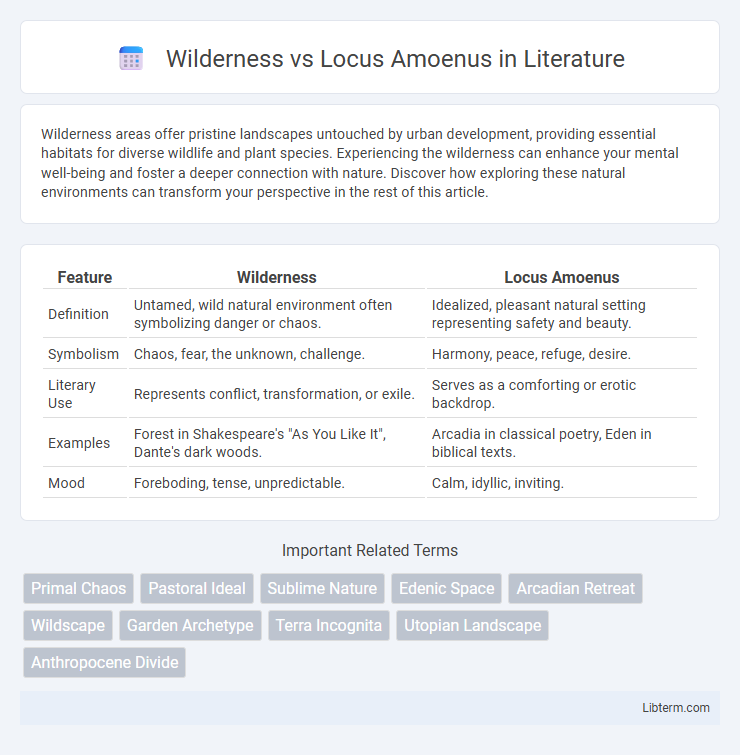Wilderness areas offer pristine landscapes untouched by urban development, providing essential habitats for diverse wildlife and plant species. Experiencing the wilderness can enhance your mental well-being and foster a deeper connection with nature. Discover how exploring these natural environments can transform your perspective in the rest of this article.
Table of Comparison
| Feature | Wilderness | Locus Amoenus |
|---|---|---|
| Definition | Untamed, wild natural environment often symbolizing danger or chaos. | Idealized, pleasant natural setting representing safety and beauty. |
| Symbolism | Chaos, fear, the unknown, challenge. | Harmony, peace, refuge, desire. |
| Literary Use | Represents conflict, transformation, or exile. | Serves as a comforting or erotic backdrop. |
| Examples | Forest in Shakespeare's "As You Like It", Dante's dark woods. | Arcadia in classical poetry, Eden in biblical texts. |
| Mood | Foreboding, tense, unpredictable. | Calm, idyllic, inviting. |
Understanding Wilderness: Untamed Nature Defined
Wilderness refers to vast, untamed natural landscapes characterized by minimal human intervention, where ecosystems function in their most primal state, often featuring dense forests, rugged mountains, and diverse wildlife. It embodies unpredictability and danger, serving as a space for raw natural processes, contrasting with the controlled, serene environment of the locus amoenus, which denotes an idealized, pleasurable place of calm and beauty. Understanding wilderness involves recognizing its intrinsic ecological value and its role in fostering biodiversity, resilience, and natural cycles beyond human influence.
The Locus Amoenus: Meaning and Literary Origins
Locus Amoenus, a Latin term meaning "pleasant place," originates from classical literature to describe idealized, safe, and beautiful landscapes often depicted as gardens or pastoral settings. This literary motif contrasts with the wilderness by emphasizing order, harmony, and comfort, typically representing an escape from chaos and danger. Rooted in works by ancient poets like Virgil and Ovid, the Locus Amoenus became a symbolic setting for love, peace, and divine presence in Western literary tradition.
Contrasting Landscapes: Wildness vs. Idyllic Beauty
Wilderness embodies untamed environments marked by rugged terrain, dense forests, and unpredictable ecosystems symbolizing raw, natural power and chaos. Locus amoenus represents a cultivated, idyllic landscape often depicted as serene gardens or pastoral settings, emphasizing harmony, safety, and aesthetic pleasure. The contrast highlights the tension between the chaotic vitality of the wild and the controlled, picturesque beauty crafted to evoke comfort and order.
The Wilderness as a Space of Challenge and Transformation
The Wilderness represents an untamed, often hostile environment symbolizing challenge and personal transformation in literature and psychology. Unlike the Locus Amoenus, an idealized, safe refuge, the Wilderness demands resilience, confronting individuals with their fears and fostering growth through adversity. This space serves as a crucible for self-discovery, where trials lead to profound change and the redefinition of identity.
Locus Amoenus: Symbolism of Peace and Pleasure
Locus Amoenus symbolizes an idealized space of peace and pleasure, often depicted as a harmonious, lush landscape where humans find solace and emotional restoration. This concept contrasts with the wilderness, which embodies chaos, danger, and the unknown. Literary and artistic works use Locus Amoenus to represent safety, beauty, and an escape from life's hardships, fostering a sense of tranquility and bliss.
Emotional Responses: Fear, Awe, and Serenity
The wilderness evokes intense emotional responses such as fear and awe due to its untamed, unpredictable nature and vast, imposing landscapes. Locus amoenus, by contrast, inspires serenity and comfort through its idyllic, harmonious environments often depicted as safe havens or paradises. These contrasting emotional effects highlight how natural settings influence human psychological states and cultural narratives.
Wilderness and Cultural Narratives
Wilderness often embodies untamed landscapes symbolizing danger, mystery, and freedom in cultural narratives, contrasting with the structured, idyllic qualities of the locus amoenus. In literature and mythology, wilderness serves as a transformative space where characters confront chaos, primal instincts, and self-discovery, reinforcing its role as a catalyst for personal and societal change. This thematic use reflects humanity's complex relationship with nature, portraying wilderness as both a threat and a source of renewal within cultural imagination.
Locus Amoenus in Myth, Poetry, and Art
Locus Amoenus, a classical motif denoting an idealized, idyllic landscape, frequently appears in myth, poetry, and art as a symbol of harmony, beauty, and refuge. In Roman and Greek literature, poets like Virgil and Ovid portray Locus Amoenus as a serene natural setting where gods, nymphs, and mortals engage in peaceful interaction, emphasizing themes of paradise and escapism. Artistic depictions often highlight lush greenery, gentle streams, and tranquil environments, reinforcing its contrast to the wild, untamed wilderness and underscoring human longing for an ordered, paradisiacal realm.
Modern Interpretations: Conservation and Escapism
Modern interpretations of wilderness emphasize its role in conservation, highlighting the importance of preserving natural habitats as sanctuaries for biodiversity and ecological balance. Locus amoenus, traditionally seen as an idealized, pastoral retreat, is reimagined in contemporary contexts as spaces fostering escapism and psychological restoration amid urbanization and environmental degradation. The contrasting concepts inform environmental ethics and cultural narratives, influencing policies that balance human interaction with nature's preservation and experiential refuge.
Conclusion: The Enduring Power of Landscape Metaphors
Wilderness symbolizes untamed chaos and primal freedom, while locus amoenus represents idealized order and cultivated beauty. These contrasting landscape metaphors persist in literature and culture, shaping human perceptions of nature and self. Their enduring power lies in reflecting deep psychological and philosophical tensions between savagery and civilization.
Wilderness Infographic

 libterm.com
libterm.com